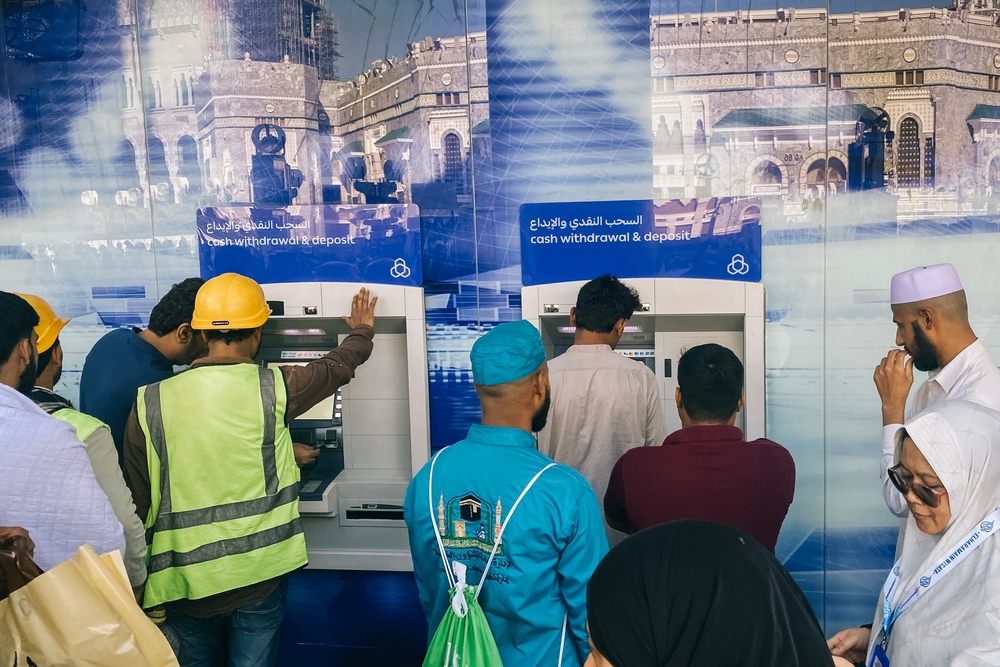https://arab.news/vg2up
RIYADH: Saudi Arabia’s banking sector led trading on the Kingdom’s stock exchange in 2024’s third quarter with a 15.14 percent market share, according to Tadawul’s latest report.
The industry was responsible for approximately SR67.5 billion ($18 billion) of transactions, ahead of the materials sector with SR60.2 billion, comprising 13.50 percent of the market.
The energy sector had 9.12 percent share in this period, with value traded reaching SR41.07 billion.
Al Rajhi Bank, the largest player in the industry on the market, recorded the second-highest activity at nearly SR22.7 billion during this period, trailing only Aramco, which led with SR27.15 billion in trades.

Customers of Al Rajhi bank withdraw money from an ATM. Shutterstock
In June, Al Rajhi Bank announced that it has become a leading target for foreign investors in the Saudi banking sector, with foreign ownership in its shares exceeding SR43 billion, representing 13.2 percent of the total.
This investment accounts for over 10 percent of total foreign investments in Saudi stocks, reflecting the bank’s prominence.
Al Rajhi Bank, valued at SR320.4 billion, is the largest bank in the Middle East and Africa, holding significant weight in global indices like MSCI Emerging Markets.
Its share price has surged over 300 percent since the launch of Vision 2030 eight years ago, and its assets have nearly doubled, showcasing its strong growth.
The bank enjoys high ratings from global financial institutions, benefiting from past economic cycles, including interest rate reductions.
Interest rates driving banks’ appeal to investors
Factors like higher interest rates, driven by the Saudi Central Bank’s alignment with the US Federal Reserve, boosted profitability through improved net interest margins, making bank stocks more attractive to investors.
Strong credit growth, particularly in corporate and real estate finance, supported by Vision 2030 projects, further enhanced the sector’s appeal.
Saudi banks also enjoyed improved asset quality, reflected by lower non-performing loans, which bolstered confidence in the sector’s stability.
The broader economic performance, with strong non-oil GDP growth, created a favorable environment, and higher bank earnings, driven by increased private sector credit demand, fueled market activity.
The materials sector’s position as the second highest in trading volume can also be largely attributed to Saudi Arabia’s ongoing Vision 2030 program, which has ignited significant demand for building materials and industrial supplies to support the Kingdom’s expansive infrastructure and construction projects.
This surge in demand could have driven higher trading activity and piqued investor interest in the sector. Additionally, Saudi Arabia’s inclusion in global indices like MSCI and FTSE Russell could have further bolstered foreign investment in this industry.
Foreign ownership growth
Strong government support added further momentum as the sector’s perceived resilience and growth potential attracted both domestic and international capital.
As of September, foreign investment in Saudi stocks has reached record levels, with over SR414.92 billion in ownership according to Tadawul data, increasing from SR365.91 billion in the same period last year.
The exchange has focused on improving market function and efficiency by implementing robust measures, such as corporate governance enhancements, increased transparency, and greater liquidity – all of which are critical for a healthy financial ecosystem.
These efforts have not only attracted international investors but have also strengthened local confidence, allowing for more robust trading volumes and values.
Foreign investors, facilitated by programs like the Qualified Foreign Investor program, introduced in 2015 and amended in 2019, now have streamlined access to the Saudi market.
This program, paired with broader reforms, has expanded the pool of eligible institutional investors, enhancing the capital inflow into sectors like banking, which tend to offer consistent returns and security.
The inclusion of Saudi Arabia in prominent global indices, such as MSCI and FTSE Russell, further amplified investor interest.
These indices serve as benchmarks for fund managers worldwide, and Saudi Arabia’s quick ascension – spending less than a year on MSCI’s watchlist before inclusion in the Emerging Markets Index – signals the international market’s confidence in the country’s reforms, according to Tadawul.
Top gainers
In the third quarter of 2024, Red Sea International Co. emerged as the top gainer on the Tadawul All-Share Index, with a price appreciation of 133.16 percent.
This real estate company has secured a SR658 million contract with Italian construction firm Webuild for constructing a staff camp at the Trojena Dam project within NEOM, Saudi Arabia.
The 12-month contract, excluding VAT, involves designing, producing, supplying, and installing prefabricated buildings, including residential areas, a mosque, dining facilities, a medical center, and a fitness center.
The project will be executed in two stages, with the second phase contingent on client approval.
An illustration of the Trojena Dam project. Webuild.
Financial impacts of the contract will be reflected from the third quarter of 2024 to the end of 2025.
Albaha Investment and Development Co. followed closely as the second top gainer, posting an 83.3 percent quarter-to-date increase, with 3.7 billion shares traded, reflecting strong investor interest in the development space.
Sasco, a prominent car service company, rounded out the top three with a 62.93 percent quarter-to-date gain, further highlighting the diversity of sectors showing significant growth.
In February, Sasco partnered with Electric Vehicle Infrastructure Co. to advance EV infrastructure, encourage the adoption of such automobiles, and reduce carbon emissions in Saudi Arabia.
The partnership will prioritize the development of fast-charging stations and public charging points across cities and provinces.
The overall performance of the Tadawul index also reflected this bullish trend, as the market concluded the third quarter with a 4.67 percent increase. TASI rose by 546 points, closing at 12,226.10, signaling growing investor confidence and strong market fundamentals across key sectors.

